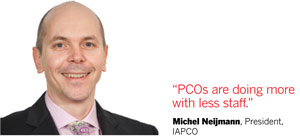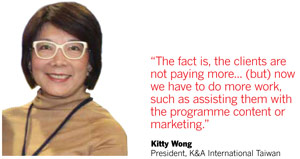
The market is looking healthy but a PCO may end up sick – unless he knows how to manage a changing business, Raini Hamdi reports
Business is on the rise for PCOs but so are stress levels it seems, as meetings get larger, lead times become shorter while the number of employees becomes smaller.
That, is the lot of the PCO business today. Both the International Association of Professional Congress Organisers (IAPCO) and the World PCO Alliance (WPCOA) report fairly similar findings at the recent IMEX in Frankfurt.
First the good news: the market is starting to look healthy again after the lean years following the debt-crisis. The total number of association meetings handled by IAPCO members (115 from 40 countries) last year rose to 2,826, from 2,607 in 2012. Corporate meetings reversed its downward trend, rising to 3,329 in 2013, from 3,280 in 2012. Only government meetings remained down from its peak in 2011 (707), with 609 handled in 2013.
The number of participants handled also rose nearly six per cent on the previous year to 2,718,797. Average number of participants per event increased 16.5 per cent from the low of 2011 (345) to 402 in 2013.
Capping the good news is, roomnights have risen by a staggering 20 per cent-plus from 2012, perhaps indicating a return to service providers from impersonal online facilities. Michel Neijmann, IAPCO president, said: “This shows we could still fulfil the needs of the clients in this area and that people do want to communicate one-on-one with people for bookings, plus I think the PCOs also got smarter in packaging deals in a more creative way while clients too got smarter in realising that Expedia, Booking.com and the like might not necessarily be cheaper.”
Neijmann attributed the increase in association meetings and corporate meetings to “economic trust”, resulting in companies being “daring to invest” again in events.

WPCOA, comprising 20 PCOs worldwide, saw a total growth of 15 per cent in 2013 compared to 2012. Together, they handled over 500 congresses with over 450,000 delegates in 2013, said WPCOA.
However, a WPCOA study also shows that the lead time is getting shorter to the point it really puts to test an organiser’s ability to be flexible and work well under pressure.
In February this year, Malaysia-based AOS Conventions & Events secured three large events – all three are for this year. In 2013, another WPCOA member, International Conference Services Denmark, secured an event with 8,000 delegates. The lead time? Three weeks.
Said Nancy Tan, managing director of Ace:Dayton based in Singapore: “It is increasingly difficult for us to plan our budget. Usually we do not choose events that are too close to one another but with such lead times, it’s getting harder.”
PCOs interviewed said lead times are getting shorter for various reasons depending on each situation.
K&A International Taiwan president, Kitty Wong, pointed to an example where a pharmaceutical company doing a 500 pax event was booked at a mere six weeks’ lead time because “things got stuck with the PCO they hired or they thought they could have handled it themselves”.
Anthony Wong, group managing director of AOS, believes an increase in political strifes does play a big part in shifting business at short notice from one country to the next. At this year’s IMEX, for example, enquiries from buyers considering to shift events from Thailand were evident when news of martial law imposed in the country broke on the day IMEX opened. The Crimea incident saw Europeans boycotting Russia, and Russia avoiding Europe in favour of South-east Asia, said Wong, adding business could quickly shift not just from one country to a neighbouring country but from one continent to another as accessibility is no longer an issue with the number of flights today.
Compounding a tight timeframe for conference teams to prepare larger events, “PCOs are doing more with less staff”, said IAPCO’s Neijmann.
IAPCO’s latest survey shows the number of employees at its members collectively went down to 4,993 last year, from 5,097 in 2012 and 5,609 in 2011. Asked if this was due to more effective use of technology, he said it was probably more due to “on the whole, rising costs and the need to cut costs to ensure survival”. 2011 was also the year when the number of meetings, participants, etc, was at the lowest following the financial crisis that started in 2010.
AOS’ Wong added that human resource indeed is an issue and it’s not just a question of lack of staff but having to manage a new generation of them.
“We have to cope with last-minute bookings and shorter lead times. HR is an issue. Gen Y’ers – they don’t want to learn too deeply, so it’s how you manage this issue. It’s so different from 20 years ago,” he said.
IAPCO is stepping up education, certification and accreditation to improve the quality of PCOs. It organises meetings masterclasses, an annual seminar and regional seminars, the latter intended to bring education to countries if they could not go to IAPCO, most recent being a three-day regional seminar in Bangkok and a four-day in Sri Lanka.
But K&A’s Wong said the reality is, for a lot of PCOs, cost (including on training and education) still matters a lot although business is rising.
“The fact is, the clients are not paying more,” she said. “If clients are not paying more, we either have to squeeze our suppliers further, or try and add value in order to keep the business. So now we have to do more work, such as assisting them with the programme content or marketing,” she said.
In the lead-up to the International Association of Volunteer Effort (IAVE)’s 23rd World Volunteer Conference & Youth Conference in Queensland’s Gold Coast this month (September 15-20), PCO Pamela Holsinger, managing director of Eventcorp Australia, organised a series of roadshows “to meet with the people who head up the industry in various regions and show them how to put together a delegation to the conference”.
“I think we’re better at marketing and could see things from a different angle. Associations might say it’s a waste of time for them to do roadshows in order to boost attendance. But having done these roadshows, we now have three regions that previously were not sending delegates that are doing so now. We do the strategic thinking and marketing and creative research as to what the delegates need, what would get them to go to a conference. Gold Coast Tourism too help with marketing support to incentivise delegates to come,” said Holsinger.
As Wong summed it up: “There is business, but it’s hard to make a decent living.”






















